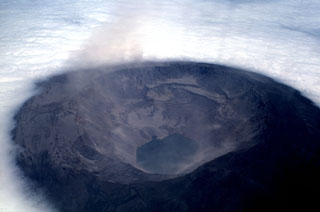Report on Fernandina (Ecuador) — 13 June-19 June 2018
Smithsonian Institution / US Geological Survey
Weekly Volcanic Activity Report, 13 June-19 June 2018
Managing Editor: Sally Sennert.
Please cite this report as:
Global Volcanism Program, 2018. Report on Fernandina (Ecuador) (Sennert, S, ed.). Weekly Volcanic Activity Report, 13 June-19 June 2018. Smithsonian Institution and US Geological Survey.
Fernandina
Ecuador
0.37°S, 91.55°W; summit elev. 1476 m
All times are local (unless otherwise noted)
IG reported that a seismic swarm at Fernandina began at 0837 on 16 June. Nine earthquakes stronger than M 2.5 were detected with the largest event, a M 4.1, located NE of the island at a depth of 4 km. An eruption that began between 1100 and 1115 was confirmed by guides on a passing boat passing, and by thermal anomalies identified in satellite images. The eruption occurred from a radial fissure on the NNE flank, producing gas plumes with low ash content that rose 2-3 km and drifted more than 250 km WNW. Lava flows reached the sea within a few hours. After two days of intense eruptive activity, tremor levels decreased significantly, thermal anomalies decreased (though continued to remain intense), and a significant drop in sulfur dioxide emissions was recorded.
Geological Summary. Fernandina, the most active of Galápagos volcanoes and the one closest to the Galápagos mantle plume, is a basaltic shield volcano with a deep 5 x 6.5 km summit caldera. The volcano displays the classic "overturned soup bowl" profile of Galápagos shield volcanoes. Its caldera is elongated in a NW-SE direction and formed during several episodes of collapse. Circumferential fissures surround the caldera and were instrumental in growth of the volcano. Reporting has been poor in this uninhabited western end of the archipelago, and even a 1981 eruption was not witnessed at the time. In 1968 the caldera floor dropped 350 m following a major explosive eruption. Subsequent eruptions, mostly from vents located on or near the caldera boundary faults, have produced lava flows inside the caldera as well as those in 1995 that reached the coast from a SW-flank vent. Collapse of a nearly 1 km3 section of the east caldera wall during an eruption in 1988 produced a debris-avalanche deposit that covered much of the caldera floor and absorbed the caldera lake.
Source: Instituto Geofísico-Escuela Politécnica Nacional (IG-EPN)

